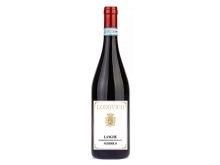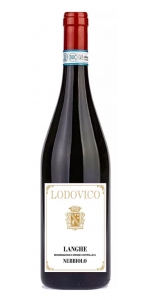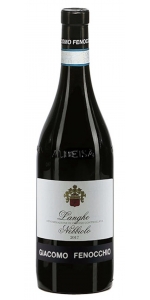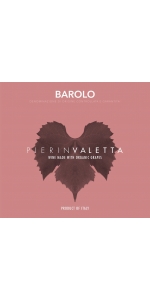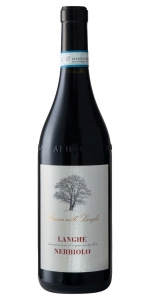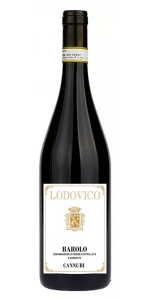Lodovico Langhe Nebbiolo 2020
Lodovico Langhe Nebbiolo is made from 100% Nebbiolo.
Bright ruby-red which softens on ageing; delicate, fruity nose of raspberries and violets that becomes ethereal over time; dry, balanced flavor, with good body that softens after ageing and lingers on the finish.
Vine: Nebbiolo
Vineyards: North-est facing with Guyot pruning (7-9 buds / vine).
N° Vines / hectare: 4,000
Yield / hectare: 70-80 q / Ha
Plant year: 2007
Nebbiolo is a native black grape variety of Piedmont that gives birth also Barolo and Barbaresco. The name ‘Nebbiolo’ derives from the word ‘fog’ and there could be two reasons. The first hypothesis traces the name of Nebbiolo back to the obscured, almost clouded appearance of the grape, covered with abundant bloom. The second hypothesis, more suggestive, is linked to the very late ripening of the grapes: the Nebbiolo grape harvest often takes place in late October, when the vineyards are enveloped in morning mists.
It pairs with pasta, soup, meats, seasonal dishes and medium-aged cheeses.
Fenocchio DOC Nebbiolo Langhe Bussia is made from 100 percent Nebbiolo.
The color is a deep ruby red with garnet reflections and an intense and fruity bouquet of plum and cherry. The flavor is dry with good body, well balanced tannins and harmonious with hints of licorice and rose.
Parcel is 2 hectares (5 acres) planted at 300 meters above sea level.
Pairing well with all types of food, from appetizers to cheeses with red and white meat.
Pierinvaletta Organic Barolo Langhe is made from 100 percent Nebbiolo .
Elegant with a good structure and a long pleasant finish.
No filtration before bottling.Wine was aged in Oak foudre for 24 months.
Average 40 years (oldest vines are 70 years old)
Pair with meat, steak.
Quercia nelle Langhe Nebbiolo Langhe is 100% Nebbiolo.
Garnet red, bouquet is fruity with reminiscences of violets and raspberries.
Full bodied, interesting and intense.
Manual Harvest at the beginning of October.
The grapes are delicately pressed and the stalks are removed. The limpid must ferment in stainless steel vats at a controlled temperature of 26°C for 12 days. After racking the new wine is put into 25 and 30 hl Slavonian oak barrels for long months. Next, it is bottled for reaching the market.
Pairs well with ribeye, red meats.
Lodovico Barolo Cannubi is made from 100% Nebbiolo.
With a ruby-red color, the Barolo Cannubi has a rich bouquet which gradually recalls the scents of roses flowers, truffles and wood spice. The palate is at first elegant and refined, then is begins to gain in complexity with a little breathing or decanting.
Vine: Nebbiolo, sub-variety Lampia and Michet
Grapes provenance: Cannubi Boschis vineyard in the village of Barolo
Soil: composed mainly of large clayey limestone marls and sands
Vineyards: South-est facing with Guyot pruning (6-8 buds / vine)
N° Vines / hectare: 5000
Yield / hectare: 50-55 q / Ha
Plant year: 1970
Size of the vineyard: 1.3 hectare (3.21 acres) in the family since 1996 out of 40 hectares (98.8 acres) total for Cannubi.
Average height: 250-260 mt
Nebbiolo is a native black grape variety of Piedmont that gives birth also Barolo and Barbaresco. The name ‘Nebbiolo’ derives from the word ‘fog’ and there could be two reasons. The first hypothesis traces the name of Nebbiolo back to the obscured, almost clouded appearance of the grape, covered with abundant bloom. The second hypothesis, more suggestive, is linked to the very late ripening of the grapes: the Nebbiolo grape harvest often takes place in late October, when the vineyards are enveloped in morning mists.
Pairs with aged cheeses, red meat, rich/earthy dishes, truffle risotto, pasta with sausages and mushrooms. Braised or roasted meats.
Lodovico Barolo Cannubi is made from 100% Nebbiolo.
With a ruby-red color, the Barolo Cannubi has a rich bouquet which gradually recalls the scents of roses flowers, truffles and wood spice. The palate is at first elegant and refined, then is begins to gain in complexity with a little breathing or decanting.
Vine: Nebbiolo, sub-variety Lampia and Michet
Grapes provenance: Cannubi Boschis vineyard in the village of Barolo
Soil: composed mainly of large clayey limestone marls and sands
Vineyards: South-est facing with Guyot pruning (6-8 buds / vine)
N° Vines / hectare: 5000
Yield / hectare: 50-55 q / Ha
Plant year: 1970
Size of the vineyard: 1.3 hectare (3.21 acres) in the family since 1996 out of 40 hectares (98.8 acres) total for Cannubi.
Average height: 250-260 mt
Nebbiolo is a native black grape variety of Piedmont that gives birth also Barolo and Barbaresco. The name ‘Nebbiolo’ derives from the word ‘fog’ and there could be two reasons. The first hypothesis traces the name of Nebbiolo back to the obscured, almost clouded appearance of the grape, covered with abundant bloom. The second hypothesis, more suggestive, is linked to the very late ripening of the grapes: the Nebbiolo grape harvest often takes place in late October, when the vineyards are enveloped in morning mists.
Pairs with aged cheeses, red meat, rich/earthy dishes, truffle risotto, pasta with sausages and mushrooms. Braised or roasted meats.
Lodovico Langhe Nebbiolo is made from 100% Nebbiolo.
Bright ruby-red which softens on ageing; delicate, fruity nose of raspberries and violets that becomes ethereal over time; dry, balanced flavor, with good body that softens after ageing and lingers on the finish.
Vine: Nebbiolo
Vineyards: North-est facing with Guyot pruning (7-9 buds / vine).
N° Vines / hectare: 4,000
Yield / hectare: 70-80 q / Ha
Plant year: 2007
Nebbiolo is a native black grape variety of Piedmont that gives birth also Barolo and Barbaresco. The name ‘Nebbiolo’ derives from the word ‘fog’ and there could be two reasons. The first hypothesis traces the name of Nebbiolo back to the obscured, almost clouded appearance of the grape, covered with abundant bloom. The second hypothesis, more suggestive, is linked to the very late ripening of the grapes: the Nebbiolo grape harvest often takes place in late October, when the vineyards are enveloped in morning mists.
It pairs with pasta, soup, meats, seasonal dishes and medium-aged cheeses.
Founded by Lodovico Borgogno in 1950, the Estate is now run by 4th generation winemakers Virna and Lorenzo Borgogno. Virna was the first woman in Italy to have received her degree in Winemaking Technique (Enologica Tecnica) from the University of Turin in 1991. She creates magnificent wines, primarily from the Nebbiolo grape. Her Barolos are long lived, structured wines that should be appreciated throughout their long life.
The estate is located in Barolo at the center of the Langhe region. The winery sits at the foothill of Cannubi, which marks the dividing line between two different soil types - the Tortonian soil to the north and west (La Morra) is generally more compact marl mixed with sand, producing elegant, softer wines that are more approachable in their youth. The Helvetian soils, with loose, less fertile sandstone and limestone rich marl, are to the south and east (Monforte and Serralunga).
The vineyards spread over 12 hectares of the most important crus in Barolo:
Barolo Cannubi 1.5 ha (the word "Cannubi" means union in local dialect - union of two soil types)
Barolo Preda 1.0 ha
Barolo Sarmassa 0.5 ha
Barolo Cerviano Merli (Novello) 3 ha
Barolo San giovanni (Monforte) 0.5 ha
Barbera d’Alba 2 ha
Dolcetto d’Alba 0.5 ha
Langhe Nebbiolo 1.5 ha
Timorasso (langhe Bianco) 0.5 ha
Fenocchio DOC Nebbiolo Langhe Bussia is made from 100 percent Nebbiolo.
The color is a deep ruby red with garnet reflections and an intense and fruity bouquet of plum and cherry. The flavor is dry with good body, well balanced tannins and harmonious with hints of licorice and rose.
Parcel is 2 hectares (5 acres) planted at 300 meters above sea level.
Pairing well with all types of food, from appetizers to cheeses with red and white meat.
- back
Boussey Meursault Les Meurgers is made from 100 percent Chardonnay.
The grapes for Meursault Les Meurgers are coming from the parcel located on the route to Auxey Duresses, in a horseshoe shape ravine. The grapes always reach ripeness quite early in the season. The name of this village comes from the efforts undertaken by man to plant vines in extremely stony soils. Stones that were thrown formed piles, that are called "murger".
Rich and luxurious wine, well balanced and structured in the mouth. Beautiful golden yellow in color with green highlights. It boasts aromas of toasted nuts, ripe fruit and a very delicate oak aroma. On the palate it is dry and mellow with a lingering smooth finish.
Pair with foie gras, lobster, seafood, poultry and fruit tart.
Brown Estate Chaos Theory is made from 37% Cabernet Franc 21% Cabernet Sauvignon 21% Zinfandel, 13% Merlot 8% Barbera
Dark garnet core, ruby rim. Maraschino cherry, red licorice, effervescent citrus, rose garden, chamomile blossom, Italian leather, and creme de cassis followed by cardamom, clove, cinnamon, churned cream, fresh vanilla, and a touch of graphite. Full body with juicy, creamy mouthfeel and supple tannins.
Reviews:
Mulberry, heather, and sarsaparilla are uniquely joined in this plush blend of Cabernet Franc, Cabernet Sauvignon, and Zinfandel. Notes of cardamom, cinnamon stick, chocolate-raspberry cake are dreamy. Vivid acid structure is within a frame of spiced, dried spring flowers and plum liqueur.
-Tasting Panel 93 Points
This concentrated Merlot-Zinfandel-Petite Sirah blend brings waves of cherry gastrique, raspberry liqueur, violets and caramel on the nose, while the palate leans into ripe blueberries, dark chocolate and raspberry coulis with expansive texture and velvety tannins.
-Wine Enthusiast 93 Points

